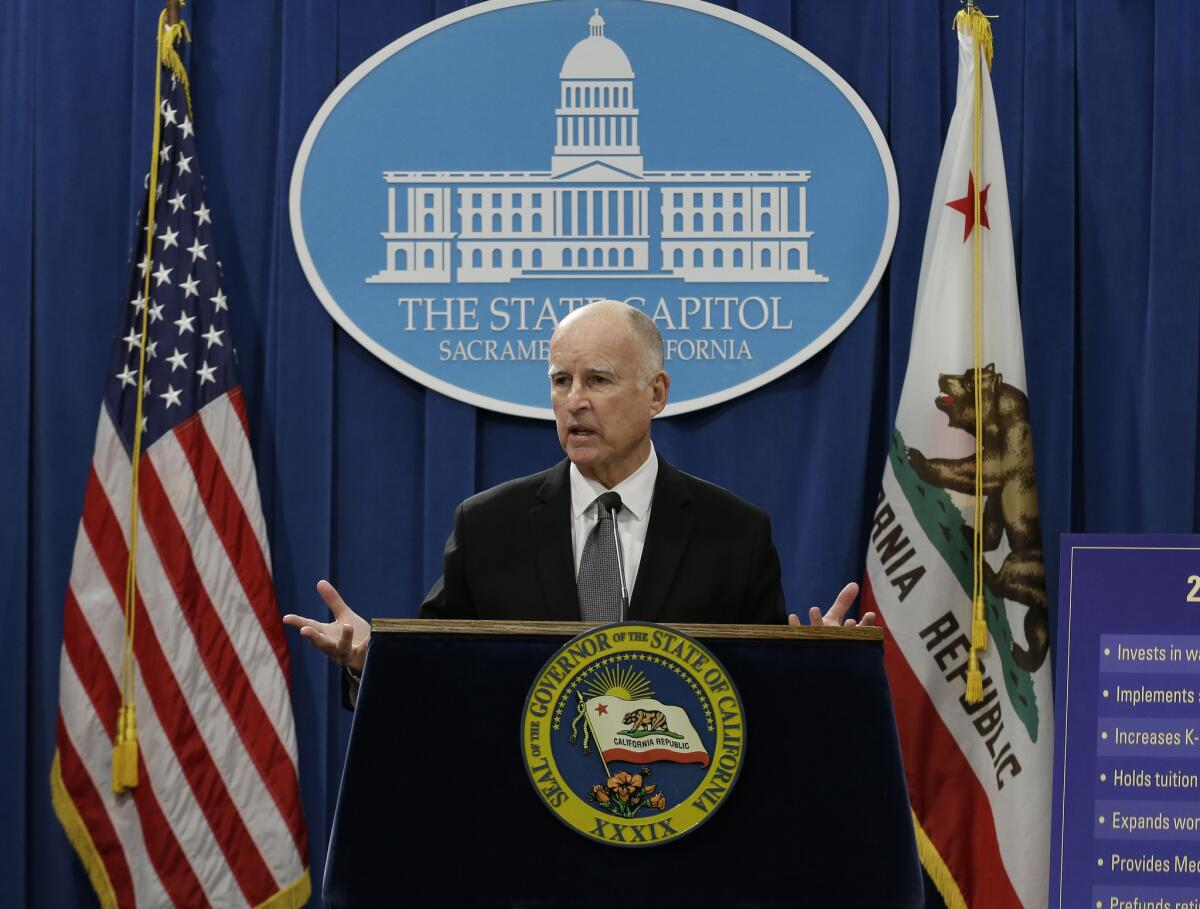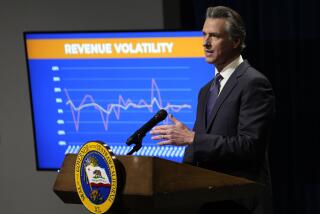Gov. Brown’s budget plan would slash state arts grant spending

- Share via
Last spring, some heavy lifting in the California Legislature produced a budget bill that gave state arts funding its first legislated boost in more than a decade, albeit a modest one.
California taxpayers’ investment in the California Arts Council, the state’s grantmaking agency for nonprofit arts organizations and public school arts education, rose from $1 million to $6 million.
But Gov. Jerry Brown’s budget proposal for the coming 2015-16 year puts advocates of arts spending back at the bottom of the hill. His spending plan gives the arts council just $1.1 million from the tax-fed general fund.
It was a disappointment, although not exactly a surprise for arts advocates who’d hoped the governor at least would endorse the $6-million status quo. They say they’re ready to repeat last year’s effort and push for increases during the coming budget deliberations.
Overall, Brown is proposing a $4.9 milion arts council budget, with the bulk of the money coming from federal coffers and donations.
The $1.1 million in state taxes that Brown wants to allocate for the arts council is one one-thousandth of a percent of the $113.3 billion in overall general fund spending he proposed last week.
That continues a longstanding policy going back to the early 2000s in which California governors invariably have proposed anteing up the bare minimum from state tax coffers that’s needed to qualify for about $1 million in matching federal funds from the National Endowment for the Arts.
Consequently, the most reliable source of California’s arts grant funding in the 21st century has been charity – more than $2 million a year in contributions from California motorists who voluntarily pay extra for special arts-supporter license plates designed by noted California artist Wayne Thiebaud.
Assemblyman Adrin Nazarian (D-Sherman Oaks), a leader of last year’s push to increase the tax-fed portion of the arts grant budget, said he wasn’t surprised that Brown’s latest proposal expresses parsimony toward the arts.
Nazarian said that the Democratic governor is understandably wary of increasing spending despite growing tax coffers. Brown’s new budget proposal calls for a 4.9% increase in general fund spending, with an emphasis on education.
But the written introduction to his spending plan concludes that with continued economic growth uncertain, “it is obvious the state cannot take on ongoing new spending commitments.”
Nazarian said he’s confident that if arts advocates in and out of the Legislature keep pressing for higher funding during this year’s budget proceedings, the result ultimately should be a spending plan that builds on the 2014 increase.
But because state law empowers governors to reduce any line item in the budget passed by the Legislature, Brown ultimately would have to be on board with any increase.
“This is something we need to speak up on until it gets to the point that [Brown] automatically includes” the previous year’s arts appropriation as a starting point for the next round of budgeting, Nazarian said. He said he’d propose “at a minimum” that the coming year’s budget allocate $10 million in general fund money to the arts council.
Richard Stein, president of California Arts Advocates, a private nonprofit arts lobbying group, said he wasn’t surprised that Brown had not accepted the current $6 million tax allocation as a benchmark for ongoing arts funding. Despite that, he said, “we’re very optimistic that there will be another increase this year” after the budget process has played out.
“The kinds of things we’re hearing from elected officials indicate they would like to build arts [expenditures] up to a level more appropriate to the pride we take in the state’s premier role” as an innovator in arts and culture, Stein said.
Nazarian said there’s momentum in the Legislature to respond to California’s consistent national ranking at or near the bottom in per capita government arts-grant spending.
“It’s more than slightly absurd, and it’s extremely frustrating, given what the arts and entertainment economies do” to boost California’s economy and tax cofffers, Nazarian said. “For us not to be making an appropriate investment has long-term consequences – if not now, then in 10 years or 20 years, when the next generation of youth is stepping into the economy.”
If Brown’s budget proposal were enacted, the arts council budget would total $4.9 million, including $1.1 million in federal matching funds and $2.2 million in license plate contributions. That’s about 13 cents in arts spending per California resident, using the U.S. Census Bureau’s 2013 state population estimate of about 38.3 million.
California’s funding of its state arts agency remains a fraction of the national per capita average of $1.15 reported by the National Assembly of State Arts Agencies.
In addition to the donations from motorists, who pay $50 (regular) or $98 (vanity) extra for new license plates, and $40 or $78 for renewals, the budget anticipates $250,000 in contributions from California taxpayers via their state income tax returns. The forms include a box that filers can check off, then indicate how large a donation they’d like to make by adding to their payment or subtracting from their refund.
A little savvy re-branding (and a somewhat improved economy) has significantly improved the yield from the tax form checkoffs. For the 2010 and 2011 tax years, when the checkoff box was labeled “Arts Council Fund,” contributions came to $165,000 per year. Under the rules, that wasn’t enough to keep a spot on the tax return forms for 2012.
New legislation put the arts council’s donation box back on forms for the 2013 returns that most taxpayers would have filed before last April’s deadline. This time the label was “Keep Arts in Schools Fund.” The yield was $256,421 from 21,351 taxpayers – an average contribution of $12.
Follow @boehmm of the L.A. Times for arts news and features
More to Read
The biggest entertainment stories
Get our big stories about Hollywood, film, television, music, arts, culture and more right in your inbox as soon as they publish.
You may occasionally receive promotional content from the Los Angeles Times.











